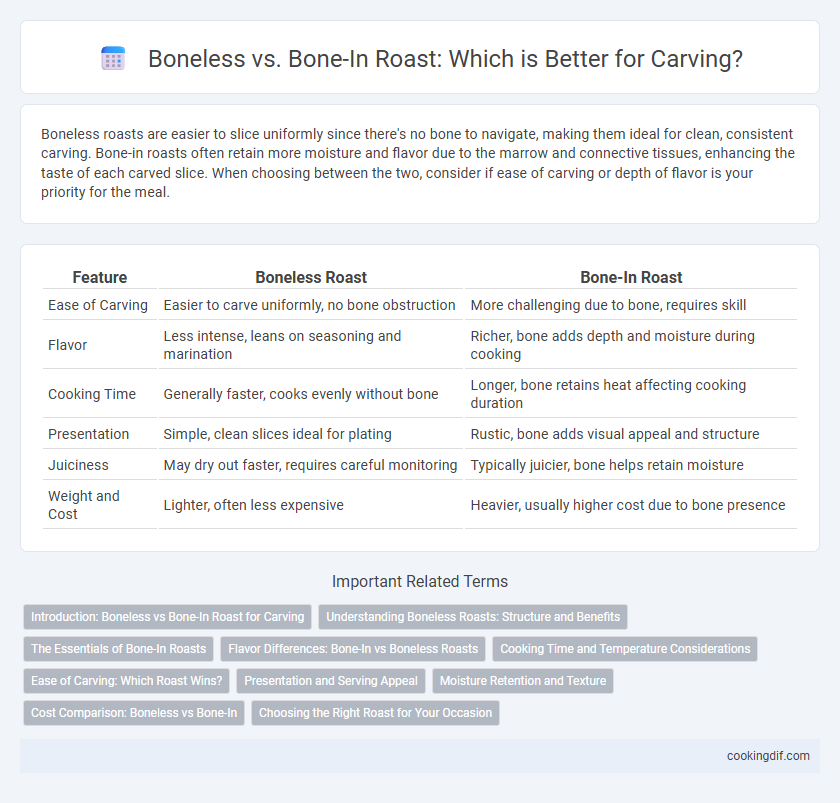Boneless roasts are easier to slice uniformly since there's no bone to navigate, making them ideal for clean, consistent carving. Bone-in roasts often retain more moisture and flavor due to the marrow and connective tissues, enhancing the taste of each carved slice. When choosing between the two, consider if ease of carving or depth of flavor is your priority for the meal.
Table of Comparison
| Feature | Boneless Roast | Bone-In Roast |
|---|---|---|
| Ease of Carving | Easier to carve uniformly, no bone obstruction | More challenging due to bone, requires skill |
| Flavor | Less intense, leans on seasoning and marination | Richer, bone adds depth and moisture during cooking |
| Cooking Time | Generally faster, cooks evenly without bone | Longer, bone retains heat affecting cooking duration |
| Presentation | Simple, clean slices ideal for plating | Rustic, bone adds visual appeal and structure |
| Juiciness | May dry out faster, requires careful monitoring | Typically juicier, bone helps retain moisture |
| Weight and Cost | Lighter, often less expensive | Heavier, usually higher cost due to bone presence |
Introduction: Boneless vs Bone-In Roast for Carving
Boneless roasts offer ease of slicing and uniform thickness, making them ideal for precise carving with less effort. Bone-in roasts retain moisture and enhance flavor during cooking, resulting in a juicier, more tender meat that can elevate the carving experience. Choosing between boneless and bone-in depends on the desired balance of convenience versus taste and moisture retention.
Understanding Boneless Roasts: Structure and Benefits
Boneless roasts offer a uniform shape that simplifies carving and ensures even cooking, making them ideal for consistent slices. Their lack of bone reduces cooking time and allows for easier seasoning penetration, enhancing flavor throughout the meat. This structure provides convenience for cooks and results in tender, easy-to-serve portions.
The Essentials of Bone-In Roasts
Bone-in roasts retain more moisture during cooking, resulting in a juicier and more flavorful meat ideal for carving. The bone acts as a natural heat conductor, ensuring even cooking and enhanced tenderness around the bone-in area. Proper carving technique preserves the integrity of the meat fibers, allowing for better slice presentation and texture.
Flavor Differences: Bone-In vs Boneless Roasts
Bone-in roasts deliver richer, more concentrated flavors as the marrow and connective tissues slowly infuse the meat during cooking, enhancing moisture and succulence. Boneless roasts, while easier to carve and cook evenly, may lack the depth of taste that the bone imparts, often requiring additional seasoning or marinating. Choosing bone-in roasts is ideal for those seeking a robust, traditional roast flavor, whereas boneless cuts suit convenience and uniform slicing without sacrificing tenderness.
Cooking Time and Temperature Considerations
Boneless roasts generally cook faster and more evenly due to the absence of bone, allowing heat to penetrate uniformly, typically requiring a lower internal temperature of about 135degF for medium-rare. Bone-in roasts take longer to cook because the bone acts as an insulator, often necessitating a higher cooking temperature or extended cooking time to reach the desired doneness, with an internal temperature target around 145degF for medium. Adjusting cooking time and temperature is essential for optimal carving results, ensuring tenderness and juiciness based on roast type.
Ease of Carving: Which Roast Wins?
Boneless roasts offer superior ease of carving due to their uniform shape and absence of bones, allowing for smooth, consistent slices ideal for presentation. Bone-in roasts, while often more flavorful, can be more challenging to carve because the bone interrupts slicing and requires more precise technique. For effortless carving and visually appealing portions, boneless roasts generally win.
Presentation and Serving Appeal
Bone-in roasts offer enhanced presentation with an impressive, rustic appearance that creates a dramatic centerpiece for carving. Boneless roasts provide easier, cleaner slicing, allowing for uniform portions and a polished serving appeal. Choosing bone-in elevates the visual experience, while boneless prioritizes convenience and precise portion control.
Moisture Retention and Texture
Bone-in roasts retain moisture more effectively due to the insulating properties of the bone, which helps keep the meat tender and juicy during cooking. Boneless roasts cook faster and allow for easier, more uniform carving, but they risk drying out without the bone's protection. The bone-in option typically offers a richer texture and enhanced flavor, making it ideal for slower roasting methods.
Cost Comparison: Boneless vs Bone-In
Bone-in roasts generally cost less per pound than boneless roasts due to the weight of the bone, which adds to the overall weight but not edible meat. Boneless roasts provide better value for carving since all the weight is edible, despite a higher price per pound. Choosing between the two depends on balancing upfront cost savings with the desired yield for slicing and serving.
Choosing the Right Roast for Your Occasion
Bone-in roasts retain more moisture and flavor during cooking, making them ideal for rich, succulent carving experiences. Boneless roasts offer easier, more precise slicing, perfect for quick serving and neat presentation at formal gatherings. Selecting between bone-in and boneless depends on balancing desired flavor intensity with convenience for your specific occasion.
Boneless vs bone-in roast for carving Infographic

 cookingdif.com
cookingdif.com